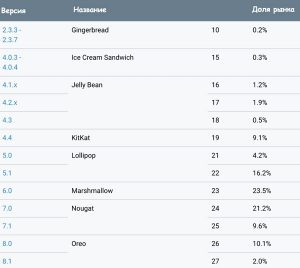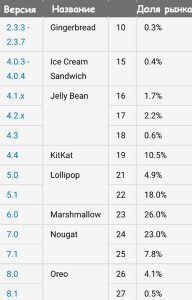 Every month, Google publishes information and the most common versions of the operating system Android. First of all, this data is intended for developers who can create, optimize and maintain the applications they create for the most current versions Android. With this data, news portals like ours can learn how OEMs are adapting to new platforms.
Every month, Google publishes information and the most common versions of the operating system Android. First of all, this data is intended for developers who can create, optimize and maintain the applications they create for the most current versions Android. With this data, news portals like ours can learn how OEMs are adapting to new platforms.
To obtain this data, Google monitors all Android devices using Google Play for at least 7 days. It follows from this that only active Android devices are taken into account when compiling statistics, and not your old one HTC, which has been collecting dust for several years.
The final version of statistics includes devices that account for at least 0.1% of active gadgets. Let's go directly to statistics.
September 2018
In August, Android 9.0 Pie was released, and in September the active release of devices with the new OS began, nevertheless, judging by the data, less than 0.1% of users could try the new “Pie”. But last year's Android Oreo was able to cover 19.2% of the market Android of devices, but more than half Android of devices on which the Play Market was used in September accounted for Marshmallow – 21.6% and Nougat – 29.3%.

As the proverb says: “A child cares about gingerbread, and an elder cares about peace,” but Android Gingerbread does not even think about retiring: compared to July 2018, the share of Gingerbread increased from 0.2% to 0.3%, equaling Ice Cream Sandwich. Most likely, the new Android Pie will bypass them by the New Year.
to the content
July 2018

After Google decided not to publish June statistics, they returned in July with new data.
Android 8 Oreo added a lot: its share among all devices was 12.1%, which is good news.
All other versions Android OS have lost ground a little. Lollipop and Marshmallow lost most of their positions – 2% each.
to the content
May 2018
Data for May was collected over 7 days up to 7 May. Android Oreo continued to gain popularity: now it is on 5.7% of devices (Oreo 8.0 – 4.9%; Oreo 8.1 – 0.8%), up 1.1% compared to last month.
Nougat also added a bit – from 30.8% to 31.1%. For other versions, the changes are as follows:
- Gingerbread – no change
- Ice Cream Sandwich – no change
- Jelly Bean – 4.3%
- KitKat – 10.3%
- Lollipop – 22.4%
- Marshmallow – 25.5%
- Nougat – 31.1%
- Oreo – 5.7%
to the content
April 2018

The data was collected by the company using the Google Play Store during the week ending April 16.
Compared to last month, Oreo gained 3.5%. Despite the release of the new version, Nougat continues to gain an audience – 30.8%. For other versions, the numbers are as follows:
- Gingerbread – no change
- Ice Cream Sandwich – no change
- Jelly Bean – 4.5%
- Kitkat – 10.5%
- Lollipop – 22.9%
- Marshmallow – 26.5%
- Nougat – 30.8%
- Oreo – 4.6%
to the content
February 2018

Android Oreo was able to hit the 1% mark despite the new Android being released last August.
Marshmallow lost the palm to Nougat – 28.5% versus 28.1%. All other versions lost ground a little.
to the content
January 2018

Despite the fact that the share of Marshmallow among all devices fell by 1.1% compared with December 2017, it remains the most popular version Android this month. In the diagram, you can see that Oreo 8.1 first hit the monthly report – 0.2%.
The rest of the versions remained practically at the same level, except for Nougat – 2% more than last month.
Which version Android are you using?
What phone do you use and what version Android does it have? Write in the comments!
